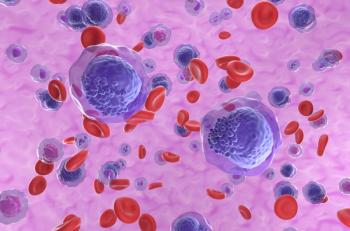
Dupixent Associated With Reduced Exacerbations, Improved Lung Function in Patients with COPD
Phase III NOTUS trial data show patients with chronic obstructive pulmonary disease and type 2 inflammation administered Dupixent experienced reduced exacerbations and superior lung function compared to placebo.
Results from the Phase III NOTUS trial (NCT04456673) demonstrated that Dupixent (dupilumab; Sanofi and Regeneron) was associated with reduced exacerbations and superior lung function compared to placebo in the treatment of patients with chronic obstructive pulmonary disease (COPD) and type 2 inflammation.1,2 These findings, published in The New England Journal of Medicine, confirmed the efficacy and safety of Dupixent in treating COPD, according to the study authors.1
“The NOTUS trial showed that [Dupixent], when added to background triple inhaler therapy, reduced the annualized rate of moderate or severe exacerbations and improved lung function in patients with COPD and type 2 inflammation,” the study authors wrote. “These results further confirm the role of type 2 inflammation in the pathobiologic disease mechanisms in a subgroup of patients with COPD and the role of dupilumab in treating this distinct COPD endotype.”1
Dupixent, a human monoclonal antibody of the immunoglobulin G4 subclass, acts as an interleukin (IL)-4 receptor alpha antagonist. Dupixent inhibits IL-4 and IL-13 signaling by specifically binding to the IL-4 receptor alpha subunit shared by the IL-4 and IL-13 receptor complexes. Dupixent inhibits IL-4 signaling through the type 1 receptor and both IL-4 and IL-13 signaling through the type 2 receptor.
Through blocking the IL-4R alpha subunit, dupilumab inhibits IL-4 and IL-13 cytokine-induced responses, such as the release of proinflammatory cytokines, chemokines, and immunoglobulin E. Prior data published in The New England Journal of Medicine showed that Dupixent was the first and only novel biologic medication to significantly improve lung function and lower severe acute exacerbations in adults with COPD.3
For the double-blind, randomized NOTUS trial, investigators randomly assigned 935 patients with COPD and a blood eosinophil count of 300 cells per microliter or above to receive subcutaneous Dupixent at a dose of 300 mg (n = 470) or placebo (n = 465) every two weeks. The trial’s primary endpoint was annualized rate of moderate or severe exacerbations; with key secondary endpoints that included changes from baseline in the prebronchodilator forced expiratory volume in one second (FEV1) at weeks 12 and 52 and in the St. George’s Respiratory Questionnaire (SGRQ) total score at week 52.
The results showed an annualized rate of moderate or severe exacerbations of 0.86 (95% confidence interval [CI], 0.70 to 1.06) among patients administered Dupixent compared with 1.30 (95% CI, 1.05 to 1.60) in the placebo cohort, with a rate ratio compared to placebo of 0.66 (95% CI, 0.54 to 0.82; P<0.001). Patients in the Dupixent cohort experienced increases in prebronchodilator FEV1 from baseline to week 12 (least-squares mean change, 139 ml [95% CI, 105 to 173]) compared to placebo (least-squares mean change, 57 ml [95% CI, 23 to 91]), showing a significant least-squares mean difference at week 12 of 82 ml (P<0.001) and at week 52 of 62 ml (P=0.02). Investigators did not find a significant between-group difference in the change in SGRQ scores from baseline to 52 weeks.
In terms of safety, reports of adverse events (AEs) were similar among both groups and consistent with the previously established profile of Dupixent. AEs were reported by 66.7% of patients in the Dupixent cohort and 65.9% in the placebo cohort.
The most frequently reported AEs were COVID-19, nasopharyngitis, headache, and COPD. Serious AEs occurred in 13.0% of patients in the Dupixent cohort and 15.9% of patients in the placebo cohort.
“Our trial confirmed that add-on dupilumab treatment reduced the rate of exacerbations and increased lung function in patients with COPD with type 2 inflammation as indicated by elevated blood eosinophil counts,” the study authors concluded.1
References
1. Bhatt S et al. Dupilumab for COPD with Blood Eosinophil Evidence of Type 2 Inflammation. N Engl J Med. 2024;390:2274-2283. DOI: 10.1056/NEJMoa2401304. VOL. 390 NO. 24. June 27, 2024.
2. Pivotal Study to Assess the Efficacy, Safety and Tolerability of Dupilumab in Patients With Moderate to Severe COPD With Type 2 Inflammation (NOTUS). ClinicalTrials.gov. March 25, 2024. Accessed July 9, 2024.
3. Sanofi. Press Release: Dupixent® (dupilumab) late-breaking Phase 3 COPD results presented at ATS and simultaneously published in the New England Journal of Medicine. News Release. May 21, 2023. Accessed July 9, 2024. https://www.sanofi.com/en/media-room/press-releases/2023/2023-05-21-18-17-12-2672904
Newsletter
Stay current in clinical research with Applied Clinical Trials, providing expert insights, regulatory updates, and practical strategies for successful clinical trial design and execution.






.png)



.png)



.png)
.png)
